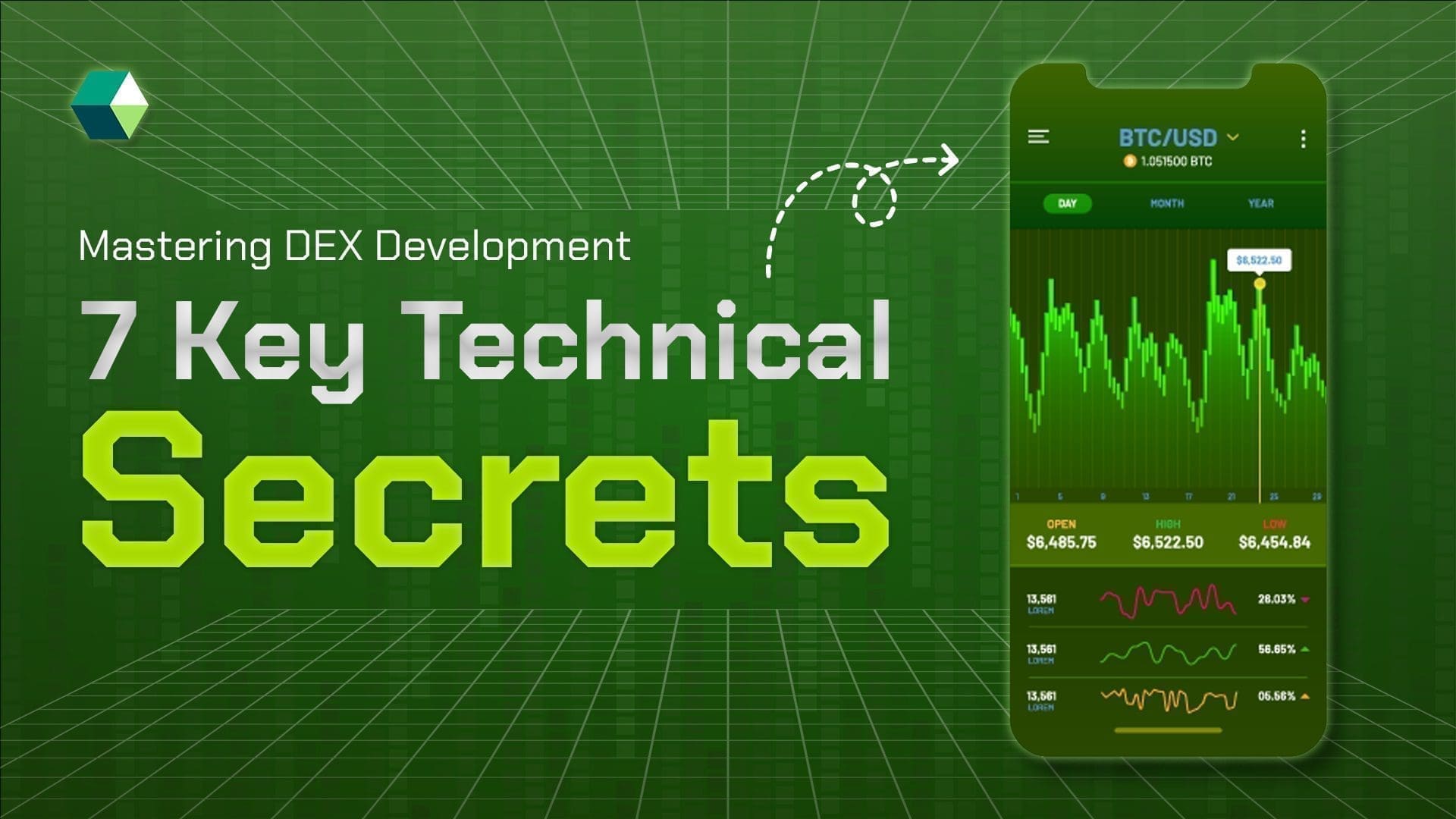
A Decentralized Exchange (DEX) is a revolutionary innovation in the crypto world, allowing users to trade digital assets in a trustless and permissionless manner. Unlike centralized exchanges that act as intermediaries, DEXs use blockchain technology and smart contracts to enable peer-to-peer transactions. However, building and managing a DEX requires deep technical expertise, strategic planning, and an understanding of user behavior.
In this guide, we will explore the seven key technical secrets to mastering DEX creation, ensuring security, scalability, and user-friendliness. Whether you’re part of a blockchain team or an independent builder, these insights will help you create a robust, future-proof platform.
What is Mastering DEX Creation?
Mastering DEX creation is all about building platforms where people can trade cryptocurrencies directly, without relying on a central authority. Instead of a third party holding users’ funds, trades happen through smart contracts—self-executing code on the blockchain that ensures secure and transparent transactions. There are two main ways trades are handled: Automated Market Makers (AMMs), which use liquidity pools, and order book models, which match buyers and sellers. Builders also focus on making DEXs secure, reducing gas fees, and improving speed using technologies like Layer 2 scaling. The goal is to create a seamless, safe, and efficient way for users to swap crypto while keeping full control of their assets.
7 Smart Strategies for a Powerful DEX
Smart Contract Optimization for Efficient Transactions
Smart contracts serve as the backbone of any Decentralized trading platform. They automate trade execution, manage liquidity pools, enforce rules, and ensure trustless transactions. Poorly optimized smart contracts, however, can lead to excessive gas fees, slow transaction speeds, and vulnerabilities to attacks.
Best Practices for Smart Contract Optimization
-
Use Proxy Contracts for Upgradability – Since smart contracts are immutable once deployed, proxy contracts allow future upgrades without disrupting existing users.
-
Minimize Storage Operations – Storing large amounts of data on-chain is expensive. Using efficient data structures such as mappings, arrays, and events can significantly reduce costs.
-
Batch Transactions – Implementing batch operations saves gas fees and improves transaction efficiency.
-
Gas-Efficient Token Transfers – Leverage ERC-20 permit functions to allow gasless approvals and reduce transaction overhead.
-
Implement Secure Coding Practices – Use the checks-effects-interactions pattern to prevent reentrancy attacks and thoroughly test contracts with tools like Hardhat, Truffle, and Foundry.
Optimizing smart contracts is crucial for ensuring cost-effective and secure transactions, making your platform more efficient and scalable.
Choosing Between AMMs and Order Book Models
Understanding the core trading mechanisms is key to building a successful DEX. The two primary models are Automated Market Makers (AMMs) and order book-based exchanges.
Automated Market Makers (AMMs)
AMMs use liquidity pools instead of traditional buyers and sellers. Prices are determined algorithmically based on the ratio of assets in the pool. Popular AMM models include:
-
Constant Product Market Maker (CPMM): Uses the x*y=k formula, ensuring that the product of the two token reserves remains constant.
-
Constant Sum Market Maker (CSMM): Ensures linear pricing but lacks arbitrage incentives.
-
Hybrid AMMs: Combine elements of CPMM and order books to improve efficiency.
Pros of AMMs
-
Always available liquidity
-
No need for market makers
-
Simple and decentralized
Cons of AMMs
-
High slippage for large trades
-
Risk of impermanent loss for liquidity providers
Order Book-Based DEXs
Order book-based platforms function similarly to traditional exchanges, matching buy and sell orders in real time.
Pros of Order Books
-
Better price discovery
-
Suitable for advanced trading strategies like limit orders
Cons of Order Books
-
Requires high liquidity to function efficiently
-
Can suffer from slow order execution due to network congestion
The choice between AMMs and order books depends on your target audience and scalability needs.
Liquidity Pool Strategies for Sustainable Growth
Liquidity is essential for the success of any DEX. Without sufficient liquidity, users will experience high slippage and inefficient order execution.
Strategies to Attract Liquidity Providers (LPs):
-
Yield Farming and Incentives – Reward LPs with governance tokens to encourage liquidity provision.
-
Dynamic Fee Structures – Adjust fees based on volatility and trading volume to optimize market efficiency.
-
Impermanent Loss Protection Mechanisms – Offer solutions like insurance pools and dynamic asset weighting to mitigate risks for LPs.
-
Multi-Asset Pools and Automated Rebalancing – Allow users to deposit various assets while ensuring optimal pricing through rebalancing algorithms.
Cross-Chain Interoperability for Wider Market Access
Expanding reach across multiple blockchains boosts usability and liquidity.
Key Technologies Enabling Cross-Chain Swaps
-
Atomic Swaps: Enable direct peer-to-peer exchanges between different blockchains.
-
Blockchain Bridges: Solutions like LayerZero and Wormhole facilitate liquidity transfer across chains.
-
Wrapped Assets: Tokenized representations of assets from other blockchains, such as Wrapped BTC on Ethereum.
Implementing cross-chain interoperability ensures wider market access and increases usability.
Ensuring Security Against Hacks and Exploits
Security breaches have resulted in billions of dollars in losses for DeFi platforms. Protecting your DEX from threats is a top priority.
Essential Security Measures
-
Regular Smart Contract Audits – Conduct third-party security audits with firms like CertiK or OpenZeppelin.
-
Multi-Signature Wallets – Use multi-sig wallets to prevent unauthorized transactions.
-
Anti-Bot Mechanisms – Prevent front-running and sandwich attacks using rate-limiting techniques.
-
Time-Locked Admin Functions – Delay key protocol upgrades to avoid instant exploitation.
A secure DEX ensures user trust and long-term sustainability.
User Experience (UX) and Gas Optimization
User-friendly design and gas-efficient transactions are crucial for the success of any DEX.
Improving UX
-
Simplified and intuitive interfaces
-
Fast transaction confirmations
-
Clear analytics and portfolio tracking tools
Optimizing Gas Fees
-
Layer 2 Scaling Solutions – Utilize Optimistic Rollups and ZK-Rollups.
-
Gasless Transactions – Use meta-transactions where relayers cover gas fees.
-
Batch Order Execution – Group multiple transactions to reduce network congestion.
A seamless UX with low transaction costs ensures high user retention.
Decentralized Governance and Sustainable Tokenomics
A well-structured governance model ensures long-term decentralization and community engagement.
Key Governance Models
-
DAO Governance: Token holders vote on protocol upgrades.
-
Quadratic Voting: Prevents whale dominance in decision-making.
-
Revenue Sharing: Distribute a portion of trading fees to token holders.
Tokenomics Strategies
-
Deflationary Models: Token burns and buybacks create scarcity.
-
Staking Rewards: Encourage long-term token holding and participation.
Strong governance and tokenomics ensure a thriving and sustainable platform.
Start Your Own DEX Today! We Can Help!
Mastering DEX creation requires expertise in smart contracts, liquidity management, security, interoperability, and governance. By implementing these seven technical secrets, builders can create a competitive and reliable platform that thrives in the evolving DeFi ecosystem.
Want expert assistance in building a powerful DEX? Nadcab Labs offers top-notch blockchain expertise to help you create next-gen decentralized trading platforms. Get in touch today!






